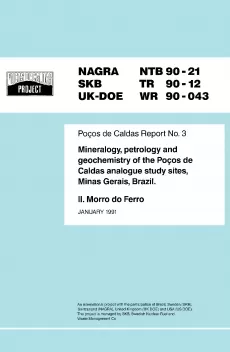
Technical Report NTB 90-21
Pogos de Caldas Report No.3Mineralogy, petrology and geochemistry of the Poços de Caldas analogue study sites, Minas Gerais, Brazil.
The thorium-rare-earth element (Th-REE) deposit at Morro do Ferro is of supergene origin and was formed under lateritic weathering conditions. The ore body forms shallow NW-SE elongated argillaceous lenses that extend from the top of the hill downwards along its south-eastern slope. The deposit is capped by a stock work of magnetite veins which have protected the underlying, highly weathered argillaceous host rock from excessive erosion. The surrounding country rocks comprise a sequence of subvolcanic phonolite intrusions that have been strongly altered by hydrothermal and supergene processes.
From petrological, mineralogical and geochemical studies and mass balance calculations, it is inferred that the highly weathered host rock was originally carbonatitic in composition and was initially enhanced in thorium and rare-earth elements compared to the surrounding silicate rocks. Intrusion of the carbonatite produced a fenitic alteration of the surrounding phonolites, consisting of an early potassic alteration followed by a vein-type Th-REE mineralization with associated fluorite, carbonate, pyrite and zircon. Subsequent lateritic weathering has completely destroyed the carbonatite, forming a residual supergene enrichment of Th and REEs.
Initial weathering of the carbonatite leading to solutions enriched in carbonate and phosphate may have appreciably restricted the dissolution of the primary Th-REE phases. Strongly oxidic weathering has resulted in a fractionation between cerium and the other light rare-earth elements (LREEs). Ce3+ is oxidized to Ce4+ and retained together with thorium by secondary mineral formation and adsorption on poorly crystalline iron and aluminium-hydroxides. In contrast, the trivalent LREEs are retained to a lesser degree and are thus more available for secondary mineral formation and adsorption at greater depths down the weathering column. Seasonally controlled fluctuations of recharge waters into the weathering column may help to explain the observed repetition of Th-Ce enriched zones underlain by trivalent LREE enriched zones.
